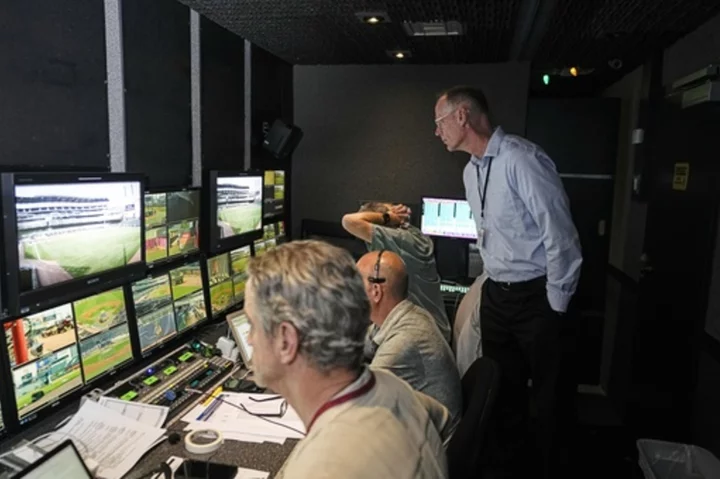Doug Johnson was answering emails at the Miami East hotel on May 30 when his phone rang with the call he had been awaiting for more than two months: Major League Baseball was taking over San Diego Padres’ television broadcasts the next day from financially troubled Diamond Sports.
“Immediately headed over to the stadium and got a chance to meet for the first time with the game announcers,” said Johnson, hired in March as MLB’s senior vice president and executive producer of local media. “I had to call every single person that worked the Padres’ home games and basically introduce myself and hire them.”
Johnson's job was to ensure a seamless transition of Padres’ telecasts from Miami on May 31 and June 1 while getting ready for the start of a homestand on June 2. He and his staff are following that playbook again this week after MLB took over Arizona Diamondbacks’ telecasts from Bally Sports Arizona starting with Tuesday’s game at Atlanta.
MLB’s takeover ended blackout restrictions tied to San Diego’s deal with Diamond, and the league says Padres games are now accessible to 3.26 million homes, up from 1.13 million under Diamond’s Bally Sports San Diego. Through the All-Star break, MLB says viewership is up 14% over the comparable period last year.
Arrangements to make that change could have filled an entire offseason. MLB had to compress that to 1 1/2 days.
“It was everything from a graphics package, to the truck, to the crew, to how are you going to get transmission done, who’s going to do master control, who’s going to do commercial insertion and then finally how do we deliver it to the distributors?” said Billy Chambers, who started in February as MLB’s executive vice president of local media following 20 years at Fox.
MLB recognized late in 2022 that Diamond might not be able to fulfill its contracts to broadcast games for its 19 regional sports networks and the sport began making contingencies. That started with hiring Chambers and Johnson, who immediately went on alert when Diamond entered bankruptcy proceedings in March.
Johnson was headed to San Diego on March 29 in case MLB took over for the Padres’ season opener against Colorado the following day.
“I was somewhere over New Mexico when I got the text from Billy Chambers saying that Diamond had called the Padres and informed them that they would make that payment,” Johnson recalled. “By the time I landed, the payment already had been made.”
MLB’s first takeover occurred at an awkward time, for the second game of a three-game road series. About 18 people were involved in the Padres’ portion of the telecast, which also relied on some of the 30 Marlins’ TV production staffers.
Johnson was among four MLB employees on site to supervise, joined by Kendall Burgess, MLB vice president of local media operations; Tim Fryer, the MLB Network’s senior segment producer of live events; and Timothy Bausch, a MLBN senior graphics operator.
Marc Caiafa, MLBN’s senior vice president of production, had built a graphics package since February that was shipped to Florida and loaded into the truck. It was built off designs created for MLB’s world feed during the pandemic.
“Everything is very hypercentric to the team,” Johnson said. “So we had to take that look, which was dominant red, white and blue, and convert it to Padres colors. Normally it takes months to build out a package like this. They were able to do it in about two weeks.”
Arrangements had to be put in place with Mobile TV Group, which supplies production trucks, cameras and replay devices for about 4,500 events annually. The company had two engineers at LoanDepot Park, and they redirected cables from the mobile unit to MLB's connection point from Bally's.
“We were released by one and hired by the other,” Mobile TV President Philip Garvin said.
Broadcast technicians such as camera operators, video and audio engineers and replay operators had been contracted by Bally from Program Productions Inc. PPI assigned a senior manager, client lead, crew manager and ProCrewz software expert to the ballpark. The cost of the technicians was reassigned to MLB, which had its office take over paying the bills.
“During this entire process there had been a million rumors and five million scuttlebutts about what’s happening or what might happen,” PPI chairman Robert Carzoli said. “We’re going to be responsible for probably over 30,000 event days this year. So it was a matter of adjusting ourselves and just saying, ‘OK, let’s take the people that we already have, let’s put some of our corporate staff on the ground to answer your questions and then it’s simply a matter of rebuilding the job.’”
The broadcast signal was transmitted to Comcast Technology Solutions in Denver, where commercials were inserted and the signal fed to the distributors for delivery to consumers. As part of the changeover, a switch was made to fiber from satellite.
“Much more cost effective and we think a better signal,” Chambers said. “The lines that we had coming out of the stadium have a higher bandwidth and lower latency.”
Padres broadcasters Don Orsillo and Mark Grant, who had red mike flags with a white “B” for the May 30 game, switched to MLB logos the next day. Bob Costas taped an introduction touting “the dawning on a new era of Padres television coverage.”
Chambers watched the first broadcast from MLB’s office in New York. Johnson was on a headset next to Fryer.
Miami won 2-1 when Jean Segura and Nick Fortes hit run-scoring singles in the ninth off Josh Hader. The game ended at 9:05 p.m. and Johnson headed to Nusr-Et Steakhouse, about a 15-minute drive away.
“I took the entire crew out to celebrate a great broadcast,” Johnson said. “We all toasted after that one.”
___
AP MLB: https://apnews.com/hub/mlb and https://twitter.com/AP_Sports

